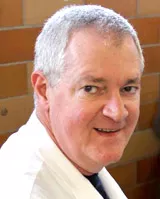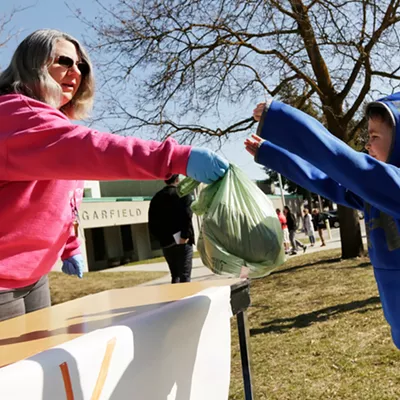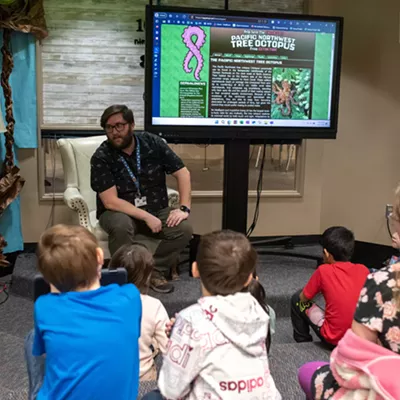The earth moved in lurches and waves after a magnitude 9.0 earthquake struck off the coast of Japan in March. You can see for yourself. Search “Japan liquefaction” on YouTube. Concrete sidewalks buckle and heave. Roads ripple under the feet of bemused Japanese workers on a smoke break.
That’s not supposed to happen. Earth, concrete … these things are solids, right?
What often happens during an earthquake, explains University of Idaho researcher Malcolm Burbank in his cramped office in Moscow, is that saturated soil grains underground — normally dense, compact, stable, in close contact with one another — get pushed apart by the pressure, turning normally solid ground into something more fluid. “So whatever’s built on top,” he says, a bit understatedly, “falls over.”
There are ways to stabilize the ground, though. The most common method is to inject a grout, often cement, into the ground. But, Burbank explains, “It’s very difficult to use those technologies where there’s already infrastructure. If you have gas lines or if you have a building in place, you have to drill holes in the foundation to inject this.” That makes it difficult in cities.
Plus, as he points out, the production of cement is responsible for a big portion of global carbon dioxide, so that method isn’t very environmentally friendly.
There’s a more effective, economical method. “The cheapest way to do it is by dynamic compaction, where you drop big weights or they do vibra-compaction, where they just shake the earth until it kind of settles. It decreases the amount of pore space, the distance between the soil grains,” he says. “Unfortunately, you can’t do that if there’s a building or infrastructure in the area.”
So in those videos of Japan, Burbank says, you don’t see either method — injection or compaction —because they were too costly or too difficult. “Those were untreated soils,” he says. “That’s liquefaction.”
But Burbank and his colleagues and students think they have an answer that costs the same in labor but considerably less in materials and is environmentally friendly: pee.
Well, not pee exactly, but urea, the organic compound that is one of the main ingredients in mammal urine. Composed of two parts ammonia and one part carbon dioxide, the compound releases those goods when you bust it up, or “hydrolyze” it. And when you add some calcium to that released carbon dioxide, you end up with a very stable form of calcium carbonate called calcite.
Burbank stands from his desk and produces from a high shelf a shoebox full of what look like charcoal briquettes, or the sandy lumps your cat leaves in its litter box. He gingerly sets one piece down, and it drops a sprinkling of sand onto his desktop, but it’s surprisingly solid. “If you propagate a seismic wave through that,” he says, “it’s not going to liquefy.”
What Burbank and his team have come up with, then, is a solution made from common chemicals — “commercially available on any continent” — that, when injected into the soil, turns the ground beneath our feet into one big cat turd briquette. It’s cheap, it’s stable, it appears to have no significant environmental effects, and because it’s injected deep down into the soils in the water table, the cementation doesn’t affect the ability for the ground to absorb and shed water.
The Idaho team has now tried its solution on seven different major soil types — two types from the Snake River, some quartz from Lane Mountain, some Palouse loess, two types of tidal soil from western Washington, even dirt from beneath a pile of leaves in Spokane — and the results have been about the same: The soil is transformed into anywhere between 2.5 and 19 percent calcite. And you should only need 4 or 5 percent, Burbanks says, to withstand a major earthquake.
The university now has a patent pending, and Burbank says his team will be working with Avista this month to see if their method can help stabilize the utility’s transmission lines in loose bluff soil.
But Burbank believes the solution has another killer application, too: cleaning up pollution.
Given a scenario in which a city block is contaminated with lead, he speculates that you could simply apply their chemical solution and lock the poisonous material up so tightly that you wouldn’t even need to dig it up and take it away — it could stay in the ground for another 30 years.
But, he says, “This is something we haven’t tested yet.”
Still, if Idaho’s solution goes worldwide, Burbank believes, it could help prevent the kind of destruction seen in Japan or — worse yet — in Haiti, where a combination of loose soil and poor infrastructure turned catastrophic when a 7.0 earthquake struck there last year.
“Haiti,” he says, “their entire Port au Prince liquefied and destroyed the port, and none of that was stabilized."



















